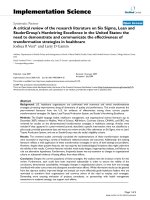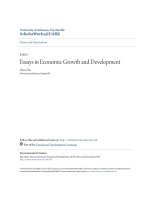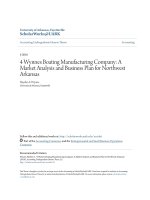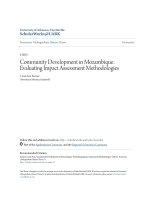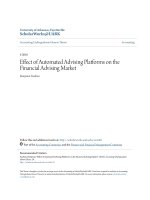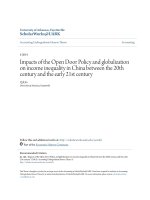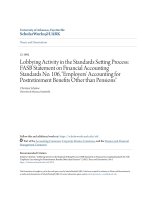Accounting undergraduate Honors theses: Essays on monetary policy rules and inflation dynamics
Bạn đang xem bản rút gọn của tài liệu. Xem và tải ngay bản đầy đủ của tài liệu tại đây (1.34 MB, 138 trang )
University of Arkansas, Fayetteville
ScholarWorks@UARK
Theses and Dissertations
8-2016
Essays on Monetary Policy Rules and Inflation
Dynamics
Saad Ahmad
University of Arkansas, Fayetteville
Follow this and additional works at: />Part of the Macroeconomics Commons
Recommended Citation
Ahmad, Saad, "Essays on Monetary Policy Rules and Inflation Dynamics" (2016). Theses and Dissertations. 1635.
/>
This Dissertation is brought to you for free and open access by ScholarWorks@UARK. It has been accepted for inclusion in Theses and Dissertations by
an authorized administrator of ScholarWorks@UARK. For more information, please contact ,
Abstract
There has been a growing trend to utilize nonlinear models to analyze key issues in monetary policy and international macroeconomics. Using traditional linear models to understand nonlinear relationships can often lead to inaccurate inference and erroneous policy
recommendations. The three essays in this dissertation explore nonlinearity in the Federal
Reserve’s policy response as well as between a country’s inflation dynamics and integration
in the global economy. My aim in accounting for potential nonlinearity is to get a better
understanding of the policy makers’ opportunistic approach to monetary policy and evaluate the inflation globalization hypothesis, which basically predicts that global factors will
eventually replace the domestic determinants of inflation.
In the first essay I develop a broad nonlinear Taylor rule framework, in conjunction with realtime data, to examine the Fed’s policy response during the Great Moderation. My flexible
framework is also able to convincingly show that the Fed departed from the Taylor rule during
key periods in the Great Moderation as well as in the recent financial crisis. The second essay
uses a threshold methodology to investigate the importance of nonlinear effects in the analysis
of the inflation globalization hypothesis. Finally the third essay investigates the relationship
between inflation and globalization, under an open-economy Phillips Curve framework, for
a panel of OECD countries with a dynamic panel GMM methodology. Contrary to most
of the previous literature, which ignores such nonlinearities, my new approach provides
some interesting empirical evidence supportive of the effect globalization has on a country’s
inflation dynamics.
Acknowledgements
I am deeply grateful to my dissertation committee chair, Andrea Civelli, for his continued
guidance and support during my graduate studies. I owe profound thanks to my committee
members, Jingping Gu and Tim Yeager, who helped improve my work and increased my
research capabilities. Lastly, this dissertation and my academic studies would not be possible
without the constant support and belief of my parents, Ahmad and Nausheen.
1
Introduction
There has been a growing trend to utilize nonlinear models to analyze key issues in monetary policy and international macroeconomics. Using traditional linear models to understand
nonlinear relationships can often lead to inaccurate inference and erroneous policy recommendations. The three essays in this dissertation explore nonlinearity in the Federal Reserve’s
policy response as well as between a country’s inflation dynamics and integration in the
global economy. My aim in accounting for potential nonlinearity is to get a better understanding of the policy makers’ opportunistic approach to monetary policy and evaluate the
inflation globalization hypothesis, which basically predicts that global factors will eventually
replace the domestic determinants of inflation. The validity of the inflation globalization
hypothesis could eventually lead to prominent changes in the conduct of monetary policy,
so it is imperative to identify the exact role global forces play in the inflation process.
In the first essay, A multiple threshold analysis of the Fed’s balancing act during the Great
Moderation, I develop a broad nonlinear Taylor rule framework, in conjunction with realtime data, to examine the Fed’s policy response during the Great Moderation. My analysis
finds that standard two-regime smooth transition models are unable to fully capture the
Fed’s nonlinear response. I therefore utilize the Multiple Regime Smooth Transition model
(MRSTAR) to get a better understanding of the Fed’s asymmetric preferences and opportunistic conduct of monetary policy. With the MRSTAR model I am able to use both
inflation and the output gap as concurrent threshold variables in the Fed’s policy response
function and am able to determine that policy makers prioritize loss of output over inflationary concerns. My flexible nonlinear framework is also able to convincingly show that the
Fed departed from the Taylor rule during key periods in the Great Moderation as well as in
the recent financial crisis.
1
The second essay, Globalization and inflation: A threshold investigation, uses a threshold
methodology to investigate the importance of nonlinear effects in the analysis of the inflation
globalization hypothesis. Accounting for potential nonlinearities in the Phillips Curve, I
show that trade openness is not rejected as a threshold variable for the effects of domestic
and foreign slack on inflation in many advanced economies, and also find a switch of the
output gap slopes from one regime to the other that is consistent with the key predictions
of the inflation globalization hypothesis. For some countries the threshold Phillips Curve
model also leads to improvements in out-of-sample forecasts over the linear Phillips models,
especially at longer horizons. Contrary to most of the previous literature, which ignores such
nonlinearities, my new approach provides some interesting empirical evidence supportive of
the effect globalization has on a country’s inflation dynamics.
Finally the third essay, A dynamic panel threshold analysis of the inflation globalization
hypothesis, investigates the relationship between inflation and globalization, under an openeconomy Phillips Curve framework, for a panel of OECD countries with a dynamic panel
GMM methodology. Previous studies on the inflation globalization hypothesis have examined this question primarily at the individual-country level. However, a panel approach
seems quite appropriate as globalization measures, such as trade openness, often exhibit
considerable cross-sectional variation. Using this framework, I find strong evidence in favor
of including global factors, as captured by the foreign output gap, in a country’s inflation
process. I further augment the dynamic panel model with a threshold component and show
that trade openness acts as a threshold variable for the effects of domestic and foreign slack
on inflation. Importantly, the switch in the output gap slopes from one regime to the other
is consistent with the key predictions of the inflation globalization hypothesis, so that in
more open economies the foreign output gap replaces the domestic output gap as the key
determinant in the country’s domestic inflation process.
2
2
Chapter 1
A multiple threshold analysis of the Fed’s balancing act during the Great
Moderation
Abstract
Empirical evidence has generally shown that the Fed follows close to a Taylor rule in setting
policy rates. This paper continues this line of inquiry by developing a broad nonlinear
Taylor rule framework, in conjunction with real-time data, to examine the Fed’s policy
response during the Great Moderation. Our analysis finds that standard two-regime smooth
transition models are unable to fully capture the Fed’s nonlinear response. Thus we utilize
the multiple-regime smooth transition model (MRSTAR) to get a better understanding of
the Fed’s asymmetric preferences and opportunistic conduct of monetary policy. With the
MRSTAR model we can use both inflation and the output gap as concurrent threshold
variables in the Fed’s policy response function and are able to determine that policy makers
prioritize loss of output over inflationary concerns. Our flexible nonlinear framework is also
able to convincingly show that the Fed departed from the Taylor rule during key periods in
the Great Moderation as well as in the recent financial crisis.
3
2.1
Introduction
For over 20 years the Taylor rule (Taylor, 1993) has been used to both shape and evaluate
the central bank’s policy actions. An important feature of the rule was that it allowed the
nominal policy rate to respond to both inflation and the output gap, reflecting the twin
concerns of monetary authorities. While Taylor intended his rule to be normative, the fact
that it was also a good match with the Fed’s interest-rate setting behavior increased its
appeal as a tool to conduct historical policy analysis (Asso and Leeson, 2012).
Figure 1 plots the recommended rates from the Taylor rule alongside the historical Fed Funds
rate and we continue to see the Fed generally being close to the Taylor rule when setting
the policy rates. In the course of time, a few modifications have been further made to the
original Taylor rule to better fit the Fed’s policy response. First there is strong indication
that policy makers are forward-looking so that expectations of inflation and the output gap
play a greater role than current or lagged values in setting interest rates (Clarida et al.,
2000). An interest-rate smoothing term was also added because in practice the Fed prefers
to change its policy rate gradually to account for the uncertainty in its economic models
(Blinder and Reis, 2005). Moreover, a focus was put on looking at the real-time data that
is actually available to the policy makers at the time of their decision (Orphanides, 2001).
Finally, the possibility of the Fed’s policy rule being nonlinear has also been examined (Kim
et al., 2005 and Hayat and Mishra, 2010).
We continue this line of inquiry by developing a broad nonlinear Taylor rule framework to
examine the Fed’s policy response during the Great Moderation, an era in which the U.S.
economy experienced low output volatility and relatively mild inflation (Ahmed et al., 2004).
Purported changes in the Fed’s conduct of monetary policy and the role they played in the
4
12
TAYLOR_FED
FED FUNDS
11
10
9
8
7
6
5
4
3
2
1
0
84
85
86
87
88
89
90
91
92
93
94
95
96
97
98
99
00
01
02
03
04
05
06
07
Figure 1: Actual Fed Funds rate and the rates under the classic Taylor Rule (Taylor, 1993).
Great Moderation have been especially analyzed and debated.1 Boivin and Giannoni (2006)
show that the Fed, by being more responsive to inflation, was able to significantly reduce the
volatility of both U.S. output and inflation levels.2 Bernanke (2012) further contends that
the Fed also helped increase economic stability by reducing the potency of exogenous shocks.
Our goal then is to compare a broad set of non-linear reponse functions, in conjunction with
real-time data, to get a better understanding of how the Fed successfully balanced its dualmandate during this significant economic period. We can then determine if the improved
monetary performance was indeed driven by a greater emphasis on policy rules as suggested
by Taylor (2012). While it is understandable that much of the recent focus has been on
the Fed’s unconventional response following the financial crisis, historical analysis is still
valuable as long as we can clearly identify the policies in place when the times were good.
See for example Favero and Rovelli (2003), Primiceri (2005), Sims and Zha (2006),
Bianchi (2013) among many others.
2
Stock and Watson (2003) determined that better monetary policy contributed up to 25%
of the decline in output volatility. Improved monetary policy was also seen as a key factor
in lower output volatility for the G7 countries (Summers, 2005).
1
5
Our nonlinear analysis is based on the Smooth Transition Autoregressive (STAR) methodology (Teräsvirta, 1994), which provides a flexible framework to test whether the Fed has
asymmetric preferences and whether it conducts policy in an opportunistic manner. By allowing for a smooth transition between regimes, the STAR models make it easier to identify
gradual policy changes and so have been a popular choice to capture nonlinear monetary
policy response functions. However one concern with the current empirical literature is the
reliance of only one threshold variable to generate the nonlinearity such as inflation as in
Martin and Milas, 2010 and Lamarche and Koustasy, 2012, output as in Alcidi et al. (2011)
and Kazanas et al. (2011) or some other macroeconomic variable like financial stress as
in Gnabo and Moccero (2013). Such a modelling approach forces one factor to be completely responsible for the observed nonlinearity in the policy response function. In order
to overcome this limitation, we also employ the Multiple Regime STAR (MRSTAR) model
as proposed by Dijk and Franses (1999) in our nonlinear analysis. Thus an important contribution of our empirical strategy is that with the MRSTAR model both inflation and the
output gap are able to act as simultaneous thresholds in the Fed’s response function. With
four distinct regimes, the MRSTAR model is able to give a more complete overview of the
various economic scenarios and contingencies the Fed faces when setting the policy rate and
so represents a better tool for understanding key policy decisions.
Using the STAR methodology, we estimate Taylor rules with real-time data for the years
1983-2007. Our first nonlinear Taylor model has a Logistic STAR1 specification in which the
Fed’s forecast for the output gap acts as the threshold variable responsible for the regime
switch.3 In the Normal regime (output gap greater than −1.66%) the Fed’s response is in
line with the Taylor rule with an inflation coefficient greater than 1 and a positive output
gap coefficient. However, the Taylor rule fails to capture the drastic drop in the Fed Funds
A monetary policy regime switch is said to occur only if there is a systematic change in
the policy response.
3
6
Rate seen in the Distressed regime (output gap lower than −1.66%). Notably, the Distressed
regime corresponds to periods with strong economic shocks such as the Savings and Loans
crisis in 1987, the recession in the early 90s and the dot-com crash in the 2000. We then
estimate a Logistic STAR2 model in which the forecast of inflation acts as the threshold
variable. We find that while the Fed does have a strong response to inflation in the Outer
regime (inflation either below 1.6% or above 3.1%), it reacts only to the output gap in the
Inner regime (inflation between 1.6% and 3.1%). So we continue to see evidence of the
Fed being opportunistic in trying to achieve its inflation objective (Orphanides and Wilcox,
2002).
Extensive misspecification tests reveal that nonlinearity remains unmapped by these Logistic
STAR models. We then turn toward the MRSTAR model, which combines the separate
regimes of the LSTAR1 and LSTAR2 specifications and so allows the Fed to have a different
response in each of these economic regimes. We find that the Fed follows the Taylor rule
only in the Normal & Outer regime of the MRSTAR model. In the Normal & Inner regime
the Fed has a very passive response, while in the Distressed & Outer and Distressed & Inner
regime the Fed’s response to inflation is less than 1 and so in clear violation of the Taylor
Principle. These findings clearly show that the Fed did depart from the Taylor rule for key
periods in the Great Moderation. From these estimated responses we can also determine
that the Fed prioritizes a loss of output over inflationary concerns, and thus propose a loss
function that can account for such asymmetric preferences. Finally we also show that the
MRSTAR model can be used to examine the Fed’s response during the financial crisis.
The rest of the paper is organized as follows. Section 2.2 reviews the literature on nonlinear
Taylor rules. Section 2.3 describes the real-time data sources. Section 2.4 gives the empirical
methodology and the Taylor rule specifications. Section 2.5 discusses the main findings while
Section 2.6 concludes.
7
2.2
Literature Review
Widespread policy failures in the 1970s pushed the Fed and other central banks to undergo
significant institutional reforms so that monetary policy could be conducted in a more systematic and transparent manner (Issing, 2008). Policy rules in this environment became
particularly attractive as a means to codify the decision making process (Poole, 1999). The
simplicity of the Taylor rule along with its emphasis on short-term interest rates enabled it
to quickly gain traction with central bankers (Kahn, 2012).
The classic Taylor rule can be expressed as
it = r∗ + πt + ζ π (πt − π ∗ ) + ζy yt
(1)
where it stands for the policy rate in the period t, r∗ is the long run real equilibrium interest
rate, πt and π ∗ represent the current and target rates of inflation, and yt is the output gap.
Taylor suggested the value of 0.5 for both the response parameters while r∗ and π ∗ were set
at 2%. Notably the Taylor rule with these parameter values ensures that the central bank
changes the nominal interest rates by more than one-for-one to any deviations of inflation
from the target. This has been referred to as the Taylor Principle and is seen as a way for
central banks to keep inflation low and stable in the long run (Walsh, 2006).
Clarida et al. (2000) showed that a linear Taylor-type rule is in fact an optimal policy
response in a dynamic New Keynesian model with sticky prices. However, a key requirement
is for central banks to have a quadratic loss function so that they give equal weight to
positive and negative deviations of inflation and the output gap from their intended targets.
Policy observors considered this loss function unrealistic, leading them to an examination
of asymmetric preferences for policy makers. Cukierman and Gerlach (2003) suggested
8
a piecewise quadratic loss function such that policy makers have the standard quadratic
specification when the output gap is negative but focus only on inflation when the output
gap is positive (actual output greater than potential). A more general specification for such
a loss function is given in Bec et al. (2002) as
L(πt , yt ) =
1
1
(πt − π ∗ )2 + we yt2 I[yt >0] +
(πt − π ∗ )2 + wr yt2 I[yt <0]
2
2
(2)
where I[.] is indicator function and we , wr are the positive relative weights to output stabilization objective (so we = 0 in the original Cukierman and Gerlach (2003) loss function).
Loss functions that capture asymmetric preferences make it optimal for the central banks to
have a nonlinear response to existing economic conditions.4
Nonlinearity in the response function can also arise if policy makers try to take advantage
of underlying economic conditions to achieve policy goals. Orphanides and Wilcox (2002)
examine the possibility that policy makers are opportunistic and only respond to inflation
when it is outside some target range. So when inflation is within this range, policy makers
do not actively try to bring inflation toward the desired target and instead react only to
shocks that move inflation further away from the target. In such a setting the policy focuses
on output when inflation is moderate but moves toward price stability as inflation becomes
either too high or too low.5
A number of different strategies have been used to model the central bank’s nonlinear response. A popular approach has been to allow policy makers to vary their response from one
Dolado et al. (2004) and Surico (2007) find evidence of the Fed having asymmetric
preferences. Asymmetric preferences and nonlinear policy responses have also been observed
for the Bank of Canada (Komlan, 2013), the Bank of England (Brüggemann and Riedel,
2011) and the South African Reserve Bank (Baaziz et al., 2013) as well.
5
Aksoy et al. (2006) find that an opportunistic policy rule is effective in achieving disinflation and at a much lower cost than standard linear rules.
4
9
regime to another. If the regime switch depends on the value of some observed economic
variable, then we can apply threshold models such as the Threshold Autoregresive (TAR)
model or the STAR model. Alternatively the regime switch can occur due to an unobserved
state variable and modeled as a Markov Switching (MS) process (Bae et al., 2012). While
this approach requires fewer prior assumptions for the switch and so is more data driven,
it also makes it harder to infer the exact economic circumstances that are generating the
nonlinear response.6 Given that central banks often have clear policy objectives, it is highly
likely that shifts in the policy response are a direct reaction to observed changes in economic
conditions. The STAR model is also convenient for modelling gradual changes in responses
as policy makers are generally wary of abrupt policy changes as it can lead to higher volatility in financial markets and cause the public to lose confidence in the central bank’s ability
to manage the economy (Blinder and Reis, 2005). Thus in our analysis, we will employ the
STAR methodology to determine if the Fed’s monetary policy changed in response to key
macreconomic variables during the Great Moderation.7
A limitation with both TAR and STAR models is that they rely on only one threshold
variable to generate the nonlinearity. In the context of monetary policy analysis, this often
leads one economic factor to be completely responsible for the central bank’s nonlinear
response function. Indeed Kim et al. (2005) have shown that in the case of the Fed, the
nonlinearity is best captured when the interaction of the output gap and inflation is included
in the standard Taylor rule specification. Thus we also consider the more flexible MRSTAR
model and in doing so allow both inflation and the output gap to act as concurrent threshold
variables in the Fed’s response function.
This is also an issue in the context of Time-Varying Parameter models that have been
also used to identify the central bank’s nonlinear response. See Boivin (2005) and Kim and
Nelson (2006) for examples of this empirical framework.
7
Gregoriou and Kontonikas (2009) have also shown that the STAR model outperforms
the Markov Switching model in out-of-sample interest rate forecasts for key OECD countries.
6
10
To our knowledge, Bunzel and Enders (2010) is the only other work that also allows both
inflation and the output gap to have nonlinear effects on the Fed’s policy response. However
there are three strong differences as it relates to the empirical analysis in this paper. First,
even when they consider both inflation and output gap as thresholds, it is still in the context
of a traditional two-regime model. Thus in their framework the Fed can only be policy active
if there is either a negative output gap or if inflation is above an interim target πt∗ (the average
inflation rate in the last two years) and so forces the same policy response in periods with
high inflation as in periods of recession.8 Second, their Taylor rule specifications are based
on the current horizon and so are unable to capture the forward-looking behavior of policy
makers as we do with our models using the Fed’s own real-time forecasts as inputs. Finally
they use the TAR framework in their analysis which, unlike the STAR models, is only able
to identify sharp changes in policy. Within the STAR framework we are also able to use
the non-linearity specification tests, as described in Dijk and Frances (1999), to explicitly
determine if the STAR model is adequate to capture the non-linear response. Such a feature
is missing in standard TAR analysis of monetary policy rules.
2.3
Data
The Great Moderation is generally considered to have begun sometime in the early to middle
’80s (Summers, 2005). Thus our analysis for this era is based on U.S. quarterly data for the
periods 1983:Q3 to 2007:Q4. We use 1983:Q3 as our starting range as it comes after the
sustained disinflation push that had been adopted by the Volcker Fed. Further, early in
the Volcker era there was a greater focus on monetary aggregates and so the Taylor rule
applied to such monetary regimes can often lead to misleading analysis (Sims and Zha,
It is also a little unclear if the threshold values in these ’opportunistic’ Taylor rule models
are actually based on grid search estimates or are taken as ad hoc, yet reasonable conjecture
of when policy makers should be reacting to output and inflation.
8
11
2006). Ending at 2007:Q4 avoids the financial crisis, during which the Fed took a number
of unconventional monetary measures (Cecchetti, 2009) that can be difficult to analyze in a
Taylor rule framework.
In much of the early literature the empirical analysis on Taylor rules was done using expost
data that had generally undergone significant revisions. Orphanides (2001) contends that
it’s better to use the real-time data that was actually available to policy makers because
Taylor rule prescriptions can vary substantially depending on the type of data that is used
in the analysis. Thus we rely only on real-time data sources.
Our first source of real-time data comes from the Greenbooks that the Fed staff specifically
prepared for the FOMC meetings. The Greenbooks contain the Fed’s latest information on
previous output and inflation levels as well as projected forecasts for different time horizons.
In our analysis, we will be using primarily the GDP deflator as the measure of the price
level so that the forecasts of inflation are just the Greenbook-projected quarter-over-quarter
(annualized) changes in the GDP deflator. Since the policy rate is not revised we just use
the annualized effective Fed Funds rate series from the St. Louis Fed (FRED) database.9
We also use the data set at the Federal Reserve of Philadelphia as another source of real-time
data. Croushore and Stark (2001) have created data vintages for key macroeconomic series
where a vintage is defined as the data that is actually available in a particular quarter. Each
vintage incorporates revisions to earlier observations, so we can obtain the real-time values
of real GDP and the GDP deflator. A quadratic detrend is then applied on the real GDP
series to get the real-time output gap estimates for this data source.10 We will be using this
data as a robustness check for the Taylor rules estimated with the Greenbook forecasts.
Unit root tests provided in Appendix A and little evidence of any non-stationary process.
Note per Orphanides and Van Norden (2002), real-time output gaps constructed by
detrending are not reliable estimates of the actual output gap for a given period and so are
used only to gauge the pressures policy makers were facing in real-time.
9
10
12
Figures 2 and 3 plot the output gap and inflation from the real-time data sources. To ease
comparison we also include the expost series using the most recent revised data available.
As can be seen the output gap forecast series from the Fed Greenbook (fgap) is closer to the
revised series (exgap) than the detrended real-time output series (rgap). Nevertheless the
forecasts of the output gap do diverge from the revised series notably in recessions and will
result in different estimates of the Taylor rule (Molodtsova et al., 2008).
8
Expost
Real-time
Greenbook
6
4
2
0
-2
-4
-6
-8
-10
84
85
86
87
88
89
90
91
92
93
94
95
96
97
98
99
00
01
02
03
04
05
06
07
Figure 2: US output gap estimates based on either expost, real-time or Greenbook data.
5.5
Expost
Real-time
Greenbook
5.0
4.5
4.0
3.5
3.0
2.5
2.0
1.5
1.0
0.5
84
85
86
87
88
89
90
91
92
93
94
95
96
97
98
99
00
01
02
03
04
05
06
07
Figure 3: US inflation estimates (the year to year change in the GDP deflator)using either
expost, real-time or Greenbook data.
13
2.4
Empirical Strategy
An advantage of Greenbook forecast data is that forward-looking Taylor rules can be easily
estimated without any instrument variable.11 Since our nonlinear analyis is based on the
STAR model, we next give a brief overview of its modelling framework.12
2.4.1
STAR Methodology
The STAR model was developed as an extension of the traditional TAR models with the idea
that there was a smooth transition between regimes. This feature makes the STAR convenient for modelling economic environments that undergo gradual changes. For a univariate
time series yt a STAR model can be specified as:
yt = θ1 xt (1 − G(st ; γ, c)) + θ2 xt G(st ; γ, c) + εt
(3)
where xt = (yt−1 , ...yt−p , z1t , ...zkt ) contains both lagged terms and other explanatory variables. The error term εt is a Martingale Difference Sequence with constant conditional
variance. The transition function G(.) is a continuous function that is bounded between 0
and 1 while st acts as the transition variable. So the STAR can be considered a regimeswitching model where regimes are represented by the extreme points of G(.) and there is a
smooth transition from one regime to the other.
The choice of the transition function G(.) plays an important role in determining the regime11
12
These forecasts are assumed to be uncorrelated with current policy shocks (Boivin, 2006).
This discussion borrows from Dijk et al. (2002) and Teräsvirta et al. (2010).
14
switching behavior. The logistic function has been commonly used so that:
G(st ; γ, c) = 1 + exp −γ
n
k=1
(st − ck )
−1
(4)
with γ as the smoothness parameter, c1 ≤ c2 ... ≤ cn the threshold values that cause the
switch between the two regimes. When n = 1 we get the Logistic STAR1 (LSTAR1) model
and the two regimes are associated with small and large values of st relative to c1 . When
n = 2 we get the Logistic STAR2 (LSTAR2) model with a regime switch when the transition
variable goes below c1 or above c2 . Finally we can have the Exponential STAR (ESTAR) case
where the exponential function is used as the transition function instead.
A key step in the STAR modelling framework is the hypothesis test of linearity against
the LSTAR and the ESTAR cases. The null in this case is θ1 = θ2 with γ and c being
unidentified nuisance parameters. In the context of STAR models a solution is to replace
G(.) with a suitable Taylor series approximation and then use a Lagrange Multiplier (LM)
test to determine nonlinearity.
Estimation of the STAR models is generally performed by NLS, with one popular approach
being the concentration of the sum of squares function to reduce the estimation complexity.
If γ and c are held fixed, then the STAR model becomes linear in the parameters and can
be estimated by OLS. Sensible starting values for γ and c are obtained by a two-dimensional
grid search with γ usually made scale-free by dividing with the sample standard deviation of
st . The grid values for c are also usually restricted to be within a subset of st so that there
are enough observations in each regime.
To accommodate multiple regimes, Dijk and Franses (1999) also develop a Multiple-Regime
STAR (MRSTAR) model by encapsulating two LSTAR models and so is useful in modeling
more complex nonlinear process.
15
The MRSTAR model is expressed as:
yt = θ1 xt (1 − G1 (s1t ; γ1 , c1 )) + θ2 xt G1 (s1t ; γ1 , c1 ) [1 − G2 (s2t ; γ2 , c2 )]
(5)
+ θ3 xt (1 − G1 (s1t ; γ1 , c1 )) + θ4 xt G1 (s1t ; γ1 , c1 ) [G2 (s2t ; γ2 , c2 )] + εt
where G1 (.) and G2 (.) are logistic functions varying between 0 and 1.
2.4.2
Taylor rule specifications
I. Forecast Taylor Rule:
it = ρit−1 + (1 − ρ)(θ0 + θπ Et πt+k + θy Et yt+h ) + εt
(6)
We begin our empirical analysis by modifying (1) to get a forecast-based Taylor rule which
serves as our baseline linear specification. The inflation response is now given by θπ =(1+ζ π )
while the intercept is θ0 = r∗ −ζ π π ∗ .13 We also as standard include an interest-rate smoothing
parameter in the linear Taylor rule. Rudebusch (2006) has raised the concern that the
smoothing preference found in estimated Taylor rules is often the result of the error term
being serially correlated. Mehra and Minton (2007) however, showed that the smoothing
term while smaller remained significant even after accounting for serial correlation. The
main explanatory variables, Et πt+k and Et yt+h , are the Fed’s respective forecasts of inflation
and the output gap with k = 1 (the one-quarter ahead inflation forecast) and h = 0 (withinquarter output gap forecast). For longer horizons we also use k = 4 (average of the k =
1, 2, 3 and 4 forecasts).
Convention is to take r∗ as constant (usually the average real interest rate) and use it
to determine the inflation target π ∗ .
13
16
II. LSTAR1 Taylor rule:
it ={[a1 it−1 + (1 − a1 ) (a0 + a2 Et πt+4 + a3 Et yt )] (1 − G(.))
(7)
+ [B1 it−1 + (1 − B1 ) (B0 + B2 Et πt+4 + B3 Et yt )] (G(.))} + εt
with G(.) = {1 + exp [−γ1 (st − c1 )]}−1
Our nonlinear specifications are based on the forecast Taylor rule in (6). We first look at the
LSTAR1 case where the output gap forecast (st = Et yt ) acts as the threshold variable. So
when Et yt > c1 we have the Normal regime and when Et yt < c1 we get the Distressed regime.
III. LSTAR2 Taylor rule:
ft ={[a1 it−1 + (1 − a1 ) (a0 + a2 Et πt+4 + a3 Et yt )] (1 − H(.))
(8)
+ [B1 it−1 + (1 − B1 ) (B0 + B2 Et πt+4 + B3 Et yt )] (H(.))} + εt
with H(.) = {1 + exp [−γ2 (st − c2 )(st − c3 )]}−1
The next case looks at the LSTAR2 where the inflation forecast (st = Et πt+4 ) serves as the
threshold variable. As in Taylor and Davradakis (2006), we prefer to take the threshold
variable as just inflation rather than inflation relative to some assumed policy target, which
simplifies the estimation and gives the Fed’s target range for inflation. The LSTAR2 model
also has two regimes: the Inner regime when c2 < Et πt+4 < c3 , and the Outer regime when
either Et πt+4 < c2 or Et πt+4 > c3 , with the Fed’s response in the outer regimes restricted
to be the same. Lamarche and Koustasy (2012) have shown that for forecast-based Taylor
rules a two-regime model cannot be rejected in favor of a three-regime model, with a different
response when Et πt+4 < c2 then when Et πt+4 > c3 , and thus the LSTAR2 is appropriate for
the Fed’s nonlinear response.
17
IV. MRSTAR Taylor rule:
it ={[a1 it−1 + (1 − a1 ) (a0 + a2 Et πt+4 + a3 Et yt )] (H(.))
(9)
+ [B1 it−1 + (1 − B1 ) (B0 + B2 Et πt+4 + B3 Et yt )] (1 − H(.))} [G(.)]
+ {[p1 it−1 + (1 − p1 ) (p0 + p2 Et πt+4 + p3 Et yt )] (H(.))
+ [q 1 it−1 + (1 − q 1 ) (q 0 + q2 Et πt+4 + q3 Et yt )] (1 − H(.))} [1 − G(.)] + εt
with G(.) and H(.) are as bef ore
Finally we consider the MRSTAR specification where forecasts for both inflation and the
output gap are used as thresholds. The resulting model has four regimes by combining the
regimes of the LSTAR1 and LSTAR2 specifications. The MRSTAR model thus allows for a
more comprehensive policy response and should provide a better understanding of how the
Fed balances its dual objective of keeping prices stable and output close to the economy’s
long-run potential.
2.5
2.5.1
Key Findings
Linear Taylor rules
Table 1 gives the estimates of the linear Taylor rule during the Great Moderation. We first
estimate the forecast-based Taylor rule in (6) using two time horizons for expected inflation,
Et πt+1 (one quarter ahead) and Et πt+4 (one year ahead). Due to data limitations we are
able to only use Et yt (current-quarter output gap forecast) in these specifications. For both
horizons the coefficient for inflation is highly significant and positive (2.14 in specification
FT1 and 2.57 in FT2). A value greater than 1 shows that policy makers are following the
Taylor Principle by responding strongly to inflation. From the estimated θ0 in FT2, we
18
determine that the Fed had an implicit inflation target of π ∗ = 2.49% during this period.14
Previous research has also shown that the Fed since the Volcker era has had an implicit
inflation target close to around 2.5% (Favero and Rovelli, 2003). Finally there is a view that
the Fed especially during the Greenspan years focused more on the core CPI rather than
the GDP deflator (Mehra and Minton, 2007). So FT3 uses the one-year-ahead forecast of
core CPI as the inflation variable, and we find little quantitative difference in the estimated
coefficients. Overall the FT2 specification gives the best fit in terms of the AIC and SBC
criteria, indicating that policy makers consider a longer time horizon in their decision making
process. This is in line with Amato and Laubach (1999) findings that a monetary policy
focused on targeting inflation over longer horizons has significantly lower welfare costs than
a policy that tries to stabilize current inflation.
We next augment (6) with the Fed’s forecast for the growth in real output. As in Orphanides
(2003), this is captured by the one-year-ahead output growth forecast relative to the potential
output. From Table 1 we observe that while the Fed has a positive response to the output
gap growth term in FGT, this variable is not significant at the10% level.15 We then examine
a Taylor rule that includes a proxy for the level of financial stress in the economy.
For the measure of financial stress, we consider both the IMF Financial Stress Index (FSI)
as well as the Chicago Board Options Exchange’s volatility index VXO. These indexes have
also been used in Martin and Milas (2012) and Gnabo and Moccero (2013) respectively.
Figure 4 shows these two measures are strongly corellated over this period. We see that
the Fed’s response has the correct negative sign but is highly insignificant in FST (see
similar results when the VXO index is used instead). Thus there is not much evidence of
the Fed actively responding to financial stress during the Great Moderation. Finally the
0
π = r ζ−θ
where r∗ = 2.85% (the average real Fed Funds rate over this period).
π
15
We also consider specification: it = ρit−1 +(1−ρ)(θ0 +θπ Et πt+3 +θ y Et yt+3 +θy Et yt−1 )
used in Orphanides (2003) and saw simillar results.
14 ∗
∗
19
